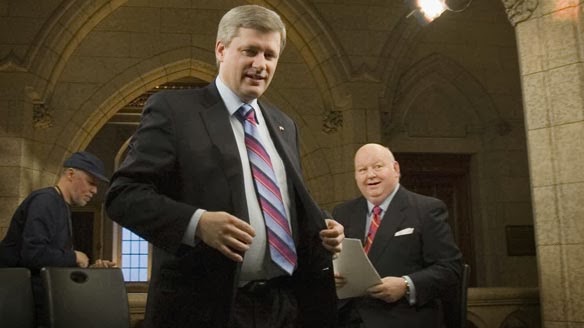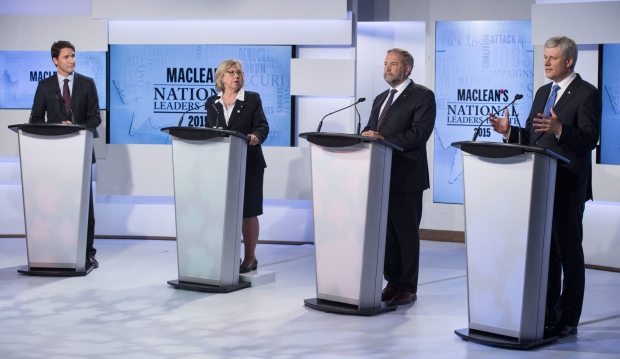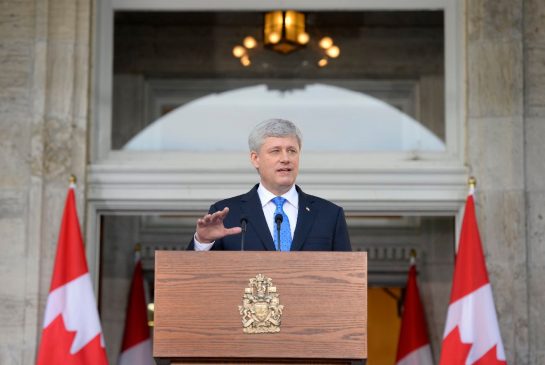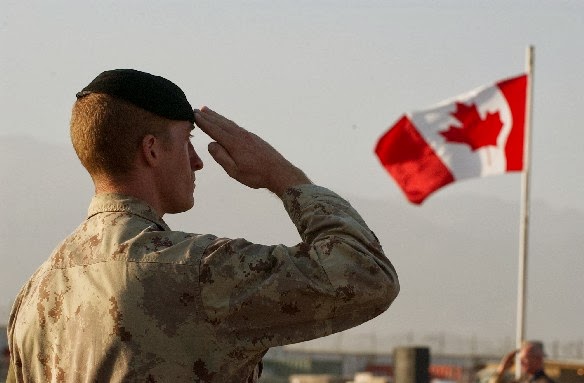
Conservative fiscal mismanagement is crippling our military
Canada’s armed forces are being suffocated by bureaucracy and cutbacks in the equipment and training they need. The Conservatives claim to be there for our military but former officials will tell you otherwise.
A Question of Priorities and Management

In 2011, Retired lieutenant-general Andrew Leslie – now one of Liberal leader Justin Trudeau’s advisers – released a report advising for the cut of bureaucracy created during the war in Afghanistan. However, in contradiction to Leslie’s warning, the Parliamentary Budget Office’s reports for 2011-2012 show the defense department increased its bureaucracy by 29.3% – part of the government’s overall 14% increase in bureaucracy.
When tasked by budget cuts and a letter sent to him from Prime Minister Stephen Harper, MacKay didn’t cut this bureaucracy, he instead opted to cut military services and the trend is continuing under Nicholson – and beyond the defense department.
Unsatisfied with the direction the military was undertaking, Leslie became vocal in June, saying, “The underlying premise of the 2011 report on transformation was that everything possible should be done to protect the front-line teeth.”
At the time, a spokesperson for MacKay responded saying the department aimed to reduce the number of bureaucrats from 29,348 to 25,408 by the end of the 2012 fiscal year, which is a far cry from the bureaucracy reductions which took place in 1999 under the previous Liberal administration when the number of civil servants was reduced to 17,037 from 37,200 in 1990. In that past year, MacKay’s department cut 1,500 workers in clerical staff at bases, gun range supervisors, radiation safety advisers, armory workers and trades helpers – people on whom the troops depend, rather than administration.
Leslie’s report underlined a 57% increase in Ottawa-based administration since Harper took office in 2006 and he said “All of those folk who have received affected notices, at least the vast majority, are to be found on bases and directly support the front-line troops. And I don’t see affected worker notices going out to where the vast majority of the growth has occurred since 2004, which is at the higher level headquarters.”
CBC recently discovered the trend was continuing under Nicholson and officials in the military are at odds with the way the Conservatives’ deep cuts are being handled – notably that rather than cutting bureaucracy, the Defense Department is cutting the operations and maintenance budget which includes training – a key tool to maintaining a modern and prepared military.
The Canada First Defense Strategy was drafted to cut the military without cutting the amount of troops – currently 68,000 nor the budget for ships and planes (which has been botched). However, that leaves cutting the necessary tools troops need, which could lead to an out-flux – it has certainly lead to an internal outcry.
Retired General Rick Hillier blasted the strategy saying “You’re going to devastate the capability of the Canadian Forces” with the cuts.
“If all the other things are untouched because you don’t want to reduce the number of people, because you’re committed to equipment, then you’re going to savage the operations and training piece of it, which means that soldiers won’t train, sailors won’t sail and men and women won’t be in their aircraft very much.”
Hillier said “The defence strategy is no longer affordable. You need to reset. You need to reshape it and you need in fact to come out with a new Canada First Defence Strategy.”
The government’s cuts will total $2.1 billion of the $20 billion annual budget the military receives by 2015. As a result, the largest hit are those working in maintenance and operations as they face 61% cuts, amid all the added bureaucrats that aren’t being touched.
“Fewer training dollars, and less maintenance money means there’s fewer platforms for people to go on an exercise with, and then at a certain point down the road, there’s going to be fewer aircraft and fewer ships for the Canadian Forces to actually deploy with,” said Dave Perry, a senior defence analyst with the Conference of Defence Associations Institute.
Leslie came back to the forefront Wednesday, telling CBC news, “This is fiscal mismanagement on a vast scale.”
“Our transformation team, over two years ago, recommended they cut consultants and contractors, which in 2010 was at $2.77 billion per year.
“Since then DND increased spending on consultants and contractors to $3 billion a year,” he told CBC News Wednesday. “This is irresponsible.”
As Nicholson shrugs off this latest storm of criticism, Canada’s procurement process has shown how the Conservatives are spending upwards of 10 times more on either inadequate or unnecessary equipment.
“Our government has made unprecedented investments in the Canadian Armed Forces. In fact, since 2006 we have boosted defence budgets by 27 per cent, roughly $5 billion in annual funding,” Nicholson said in a statement.
“The government will continue to place priority emphasis on meeting operational requirements, training within Canada, supporting the part-time reserves, undertaking national sovereignty missions and caring for ill and injured soldiers.”
Heavy armored vehicles program canceled
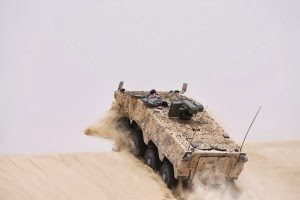
The Conservative plan announced in 2008 called for heavy investments in fighter jets (like the failed F-35), frigates, support ships, Arctic patrol ships (which will cost 10 times their worth to design and build), and an entire family of new vehicles, including two types of trucks and three types of armored vehicles.
The new revision, given the need to cut away the national deficit which hit a record breaking high of $56 billion in 2010, will now mean revision on these contracts as part of the overhaul of the operations and maintenance budget. As a result, the army’s readiness budget was cut 10% from $3.7 billion to $3.3 billion along with the aforementioned 61% cut of the operations and maintenance budget.
Industry is fuming at the changes, noting Ottawa has wasted their time and their business is needed elsewhere.
The Conservatives have botched most, if not all, of the procurement processes for new military hardware.
The F-35 fiasco

On July 17, 2010, Stephen Harper personally announced a $9 billion price tag to replace Canada’s aging fighter jets. The cost spiraled out of control and despite a campaign promise of $16 billion for these jets, the price kept rising until the price ballooned to $25 billion and then to $45 billion in June. The jets are used by the United States which warned they weren’t the best choice they made in 2010.
Canadians learned the hard way the Defense Department was covering up the actual costs of the F-35 contract in April 2012 after over a year of rigorous debate and a Motion of Contempt on the matter which triggered the 2011 election – inevitably giving Harper his coveted majority government.
The value of Arctic icebreakers

Another expert said “the numbers are staggering … There is no rhyme or reason for such a vast amount of money, especially not without clarity.” This person noted a $15 million price tag for design would be acceptable. Another said the process “is going badly wrong … [it] will be much more expensive than the F-35 acquisition. It has the potential to be an even bigger fiasco.”Then-Public Works Minister Rona Ambrose and then-Defense Minister Peter MacKay gave statements on the cots but didn’t explain why Canada was paying at least ten times more than other countries for the icebreakers.
Ambrose said “We are implementing what’s called a design and then build strategy. What that means is that we are spending more money up front on the design and production phase. That’s important because we want to make sure that the shipyards, and the navy, and the coast guard, get the design correct. MacKay’s justification was the ships were being built in Canada.
Moving headquarters?
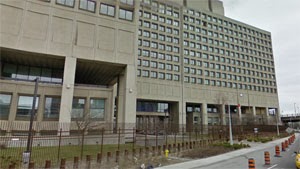
Nonetheless, changing headquarters would be a reckless move in a time when the government is cash-strapped and looking for cuts. Leslie once again weighed in, saying, “Spending $1 billion on a new headquarters, even if it’s state-of-the-art — and of course, it isn’t — is a really bad idea.”
Derek Fildebrandt responded on behalf of the Canadian Taxpayers Federation to the renovations calling it “an incredible waste of resources.”
“Department heads and leaders need to lead by example, nowhere is this more important than in the military. It should have never been approved, especially not since we’re spending hundreds of millions of dollars to move [DND] to the other end of the city… into the old Nortel buildings.”
Conclusion
The list of misuse of resources and funds in the Department of Defense goes on, including the fact Canadians learned in May 2012 that we paid 700% more than MacKay told us when the Libya conflict arose. Rather than paying $50 million for military support in the NATO effort to liberate Libya from its tyrant, Canada managed to shell out $350 million in hard economic times.Now that the Harper government is trying to reign in spending to eliminate a deficit – they created – for political purposes in 2015, it is clear that the damage they do in the process by failing to act responsibly will harm their brand.
Leslie, who has came out swinging against Harper’s mismanagement of the Department of Defense has aligned himself with Liberal leader Justin Trudeau as a military adviser. If this entails one thing, it is that a if the Liberals form a government in 2015, they will be making a clean up in National Defense – it appears they won’t have much choice. The Liberals should follow Leslie’s restructuring plan closely because the military is important for Canada’s sovereignty and security and it shouldn’t be an institution of rampant waste and mismanagement.
It is hard to imagine the NDP being in favor of this kind of mismanagement with their vocal opposition during the acquisitions but what is left to find out is what the NDP strategy for the military actually is. The Conservatives can continue to sugarcoat their management of our armed forces. While they’ve given the perception of being Canada’s pro-military party, putting on fancy militaristic displays and emphasizing the War of 1812, their cuts and management in the military have proven to be counter-intuitive and the forces risk losing vital hardware because the government simply can’t seem to get things right.
The Conservatives preach their commitment to Canada’s veterans but in the wake of their desperate search for cuts, mental health for those who have been scared by their years of service is going to be harder to access and their benefits will continue to dwindle as they face the inevitable line that the Canadian people can no longer afford them.
Do you think Conservative fiscal mismanagement is crippling our military?
 Highlights
Highlights
